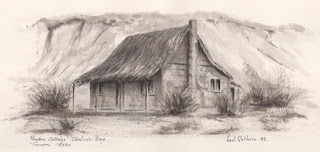The Rise and Fall of a Cow Cocky's Fortunes
The Rise and Fall of a Cow Cocky's Fortunes
Original water colour sketch by Noel Guthrie
On November 19th 1893, the West Dipton Hall in Southland hosted a public meeting to gauge support for a proposal to erect a dairy factory in the district. With the promise of milk supplied from 180 cows and with more to come along with further promises of finance, the Oreti Dairy Factory was born overnight. Builder Angus McBean had wasted little time, almost one year to the day; he completed his contract, leaving a new factory ready for its official opening on October 22nd 1894.
There was some criticism levelled at the project at the time. Many considered the summers in this part of the province too dry and unsuitable for dairying.
Having lived in Southland for five years, I controlled a little smirk when I read that article. . . .?
On completion, the Oreti Dairy Factory is thought to have been one of the first to be built in Southland. Cheese makers, James Linton and his wife were Scottish immigrants of some note and they are said to have moved from Mataura to Dipton. Acting as advisors, they were to help get the project off the ground.
That new factory had a cheese room, five by seven metres and claimed to have more than six hundred metres of shelf space, which could hold more than forty tonne of cheese.
A nine by eight-metre pressroom contained two vats, each capable of holding two thousand seven hundred litres of liquid and a derrick fitted to the concrete floor and driven by a three and a half HP engine, served as the lifting equipment to haul those heavy milk cans from each dray into the factory. Almost six hundred and seventy-five litres of milk arrived on that first morning for processing, a far greater volume than anyone anticipated.
Periods during these first few years of operation were often difficult. In the first six months, only half of the promised finance had been forthcoming, bringing pressure to bear for the continued viability of the project. A site meeting discussed leasing the factory to suppliers for twelve pounds per month. This, however, was rejected and the factory closed.
In October 1895 and for a second time, the factory was reopened. Thirteen hundred litres each day flowed into the factory and by November, this figure increased to almost two thousand seven hundred litres per day and by around 1910, the Oreti Dairy Factory reached its peak in production, producing around sixty-eight tonne of cheese per year.
At the beginning of World War One, farmers were beginning to extract cream from their milk and sending that cream to the butter factories by rail for a higher premium.
Because of that move, many of the smaller cheese factories were to face extreme hardship including the Oreti Dairy Factory. Cheese production dropped away to an all-time low of seventeen tonne per year, leaving the current owners with no option but to cease production for the second and final time.
There was a little verse I read some time ago and it stuck in my mind, now seems the appropriate time to recall it.
I don’t know, it may well have been a lament or perhaps the author drew a graph, using this verse to depict the rise and fall of a cow cocky's fortune.
Written by a Scot by the sound of things, it is entitled; Burns to his cow.
Ye muckle clamming donnert beast
I’m no that late so haud yer wheest
Let’s hope your butter fats increased
Or else the pay
Baith you and me hae been well fleeced
For mony a day.



Comments
Post a Comment